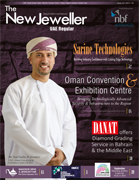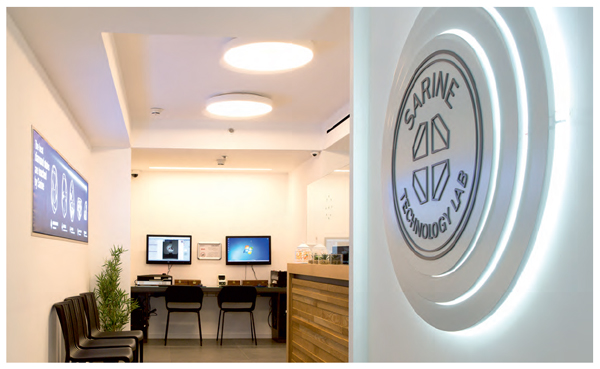
 |
|
| Home Technology / Education Events & News Archives Designs |
|
Sarine Technologies
Building Industry confidence with cutting edge Technology
 David Block
David Block Chief Executive Officer, Sarine Technologies What is your view of the state of the market so far this year and where it's heading? The market has been somewhat strange throughout this year so far. For the last 10 years, you would see that H1 was strong as the market headed to the holiday season later in the year which gave a boost to the midstream. A lot of diamonds were manufactured and sold in the first two quarters. June and July were typically slow because there was enough production for the market, so summer was weak. This is the first year for many years that the midstream has been weak in H1 – and that follows on from quite a poor H2 in 2018. If I look forward to H2 this year, I don't have any great expectations. The financial issue has intensified, especially in India, with a lot of reduction or withdrawals of credit lines by the banks. There are huge quantities of rough goods in the market – around 150 million carats over the last two years. And since there is no extra demand at the retail level, the midstream is holding those stocks. Add to that the fact that retailers want to hold lower level of polished goods because diamonds can be easily and quickly ordered, that means that the midstream is having to hold on to those stones and that is putting a burden on manufacturers. Provenance has become increasingly important in the diamond industry. What is your view on this important issue? Provenance is not new, and it is certainly not just limited to the diamond industry. Today’s consumers in general are demanding more transparency about the products they buy. The diamond industry must be able to give consumers access to the origins and history of the diamond – its complete story. They want verifiable assurance that the diamond is ethically sourced, and that their purchase has not exploited people or the environment. They want a guarantee of full traceability, and the trade is obligated to provide it if they want to make the sale. Modern customers want to know whether their diamond is natural, which mine it was sourced from, the rough stone from which it was produced, details about the factory where it was manufactured, the date of its creation, as well as information about the diamond’s unique features and grading. The Sarine Diamond Journey provenance reports will provide all this information. 
There has been a noticeable increase in the number of labgrown diamond manufacturers as witnessed at the JCK and Hong Kong shows recently. How do you see the issue of labgrown diamonds? LGDs are putting pressure on smaller and lower-quality diamonds which has pushed down demand for those goods and their prices. Manufacturers are asking themselves if they should move to other types of diamond production, meaning bigger and better quality. In general, the LGD market has become much bigger. The natural diamond industry is waking up and saying we need to differentiate. I believe there has been too much mudslinging by both the LGD makers and the natural diamond organisations. Both sides need to focus on promoting their products rather than saying why the other is bad. What is the value proposition for the product? That is the question. In general, as long as there is transparency, that's fine. Let the consumer decide. Generic marketing is critical to the health of all areas of the diamond trade. What is your view of the current state of generic marketing? It is absolutely clear that we need far more. Unfortunately, the industry took a long time to come together after De Beers decided to stop its generic marketing efforts a decade ago. As we know, De Beers was spending around $200 million a year for the benefit of the whole industry. We need more generic marketing efforts from all areas of the diamond pipeline. The Diamond Producers Association is doing good work and going in the right direction, but more is needed. Sarine has set up a fully automated diamond grading lab which is the only such facility based on artificial intelligence. You announced last year that the Sarine lab offers automated diamond grading reports based on machine learning and monitored by expert gemologists, which supplies "objective, consistent grading results". The lab also offers "science-based Light Performance grading, measuring brilliance, sparkle, fire and light symmetry which objectively assesses the beauty of the diamond and adds value beyond the 4Cs". Could you tell us a little more about this? Further use of technology is where many industries are moving. The diamond trade is behind other industries in the use of technology. Technology will play a larger role in the industry to make it better suited to today's world. Technology is not sufficiently used in the wholesale and retail sectors. The supply chain is going through changes due to technology. Even the way that diamonds are sourced and sold will change. Manufacturers for very many years have been buying boxes of diamonds which are not all the kind of goods that they need and can use, and that means they have to find clients for those goods. This will change in the future to make the process more efficient. And when we look at grading reports, we see that the 4Cs does not provide sufficient information for customers today. There can be a 20-40% spread in the reports that similar diamonds receive. There has been a big breakthrough in grading using AI. I believe this will continue to develop. What other aspects of technology would you emphasise? There are many important factors that need to be stressed. These include traceability. We have been working at Sarine on traceability solutions based on verifiable information. Blockchain has been celebrated as providing a solution for a diamond's journey from the mine to the store customer, but this does not tell the whole story. It's true that people can input information about a diamond and that information cannot be tampered with once it is in the Blockchain. However, there is an important question that must be asked: is that information verifiable? If you put unverifiable and untrue information in, that's what will come out. We need to have the real data regarding diamonds from start to finish and that has to be verifiable. Sarine has been doing intensive work on verification of solid info. A diamond's path through the system has to be based on verifiable info rather than declarations. We aim to provide solutions as a neutral, third-party player. We don't have an interest in the data that can be inputted to our Sarine Cloud. We just want the info to be true and verifiable. Has the industry considered enough how to sell its products to consumers and to tell the romantic story of what they are selling? The retail experience is stuck in the past. The retail jewelry experience in the United States is stuck in the 1980s. There are salespeople who are not experienced or knowledgeable enough. Compare the experience in a retail store with what you see and get in an Apple store. I was in a clothing store and items could be ordered in the fitting rooms digitally and brought to the customer. We want the customer to know more. This can and should include information about the good that diamonds do for miners across Africa and how they help people on the ground in many ways – from health to clinics and the environment. But it should also be more personal to the diamond that is being offered to the client. We can produce a 3D model of the rough stone from which the polished diamond is derived that a shopper is buying. The shopper then has a far deeper understanding of the diamond's path. After all, people buy based on emotions and only afterwards justify the purchase with logic. Virtual reality and augmented reality enable retailers to bridge the online digital world with the brick-and-mortar store experience. For example, with VR and AR, customers can “try on” a range of products virtually, before deciding to purchase. The retail experience has to change, and we are helping to achieve this.
|